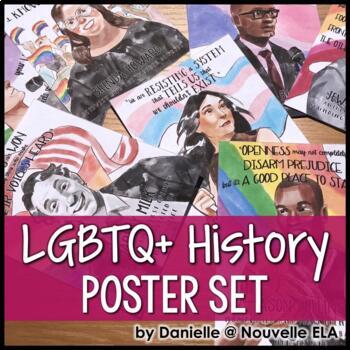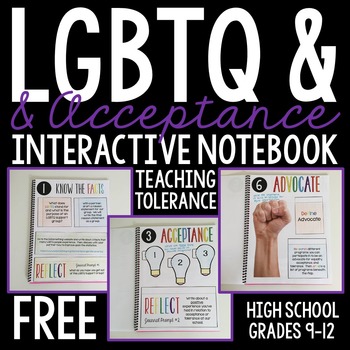Educators have an important role to play in having essential conversations with students around identity, inclusivity, and acceptance. But figuring out what steps to take can be a challenge. To help with this important work, we asked LGBTQ+ Teacher-Authors: “How can educators create LGBTQ+ inclusive classrooms where students can feel supported?” Read on for their recommendations.
5 Ways to Build More LGBTQ+ Inclusive Classrooms
Here are a few ideas from LGBTQ+ Teacher-Authors on how you might create and facilitate a more inclusive classroom.
Highlight the missing stories and voices in your curriculum.
When you’re choosing classroom reading materials, it’s important to choose texts written by the voices of those that have been traditionally oppressed as a way to help your students think deeply and talk thoughtfully about history, current events, and social issues. High school teacher Nouvelle ELA does this by including a range of LGBTQ+ leaders, thinkers, inventors, scientists, performers, and athletes in her curriculum. “For example, when my students are studying the Harlem Renaissance, we talk about the tension between the Blues scene and the ‘high art’ scene,” she says. “This allows me to share about Ma Rainey — a Blues icon and queer feminist — and gets students to think critically about differing perspectives on Black art during that era. As another example, we study the poetry and essays of Audre Lorde for rhetorical analysis.” She also adds that teachers can challenge students to find the “missing stories” in their textbooks, like the tales of women and people of color who fought at the Battle of Gettysburg.
Similarly, Brittany from The SuperHERO Teacher makes sure to include examples of LGBTQ+ characters in informational text and reading samples in all the resources she creates for middle and high school ELA. “Representation is so important. The sooner we normalize and acknowledge the fact that every single classroom will have LGBTQ+ students in it, the sooner we can make sure those students have the resources and safety they need to be confidently themselves.”
Include LGBTQ+ literature into your classroom library.
In order to ensure that all students are seeing themselves in their learning materials, a number of Teacher-Authors stressed the importance of having a classroom library filled with books written by LGBTQ+ voices or that feature diverse characters. “Inclusivity means accepting that these kids are in our classrooms right now,” says Melissa from A Teacher’s Plan, a Kindergarten and 1st grade teacher. “We, as educators, must make space for them to be seen and heard.” Bryce from The Teaching Texan, who also teaches Kindergarten and 1st grade, echoed that sentiment: “Just as we would be thoughtful in our planning to include individuals of different ethnicities, varying socio-economic backgrounds, and physical abilities, we MUST be sure that we take time to find individuals that represent LGBTQ+ individuals,” he says. “We are blessed that there are more titles than ever before with characters or individuals representing the community LGBTQ+, and we should use those resources to the best of our ability.”
For younger students, in particular, Greg from Kindergarten Smorgasboard believes that using books can be an effective way to have age-appropriate conversations about diversity. “Books give students a starting point for questions and discussions and allow us to have powerful conversations around diversity issues,” he says. “They also allow my students to see characters who look like them, which is powerful.”
Create a space where LGBTQ+ students feel safe and seen.
According to the Trevor Project’s survey on LGBTQ+ youth mental health, 42% of LGBTQ youth seriously considered attempting suicide in the past year, including more than half of transgender and nonbinary youth. So, creating a space where LGBTQ+ students feel not only seen, but also safe and welcomed is important. “As teachers, we have the chance to be another adult in students’ lives who clearly know and celebrate that LGBTQ+ people exist,” says math tutor Jane Gillette. “Be overtly welcoming. Decorate your classroom with a rainbow, pink triangle, an #IllGoWithYou sticker, or posters about people with different backgrounds. When someone who is LGBTQ+ walks into a new space, they consciously (or unconsciously) look for evidence that it is going to be safe in that space.” Similarly, 2nd grade teacher Christal from Just Add Glitter ensures that her classroom is full of signals — such as rainbows and signs that say all are welcome — in order to let her students know this is a place they can be comfortable and find acceptance.
In addition to classroom decor, high school science teacher and instructional specialist James from Bond With James also recommends recgonizing or working with the school’s GSA (Gay-Straight Alliance) group as a way to help LGBTQ+ students feel safe and welcomed. He also advises to quickly address all inappropriate or discriminatory actions because these behaviors can manifest into long-term trauma for the recipients.
Commit to using students’ correct pronouns and gender-inclusive language.
Using inclusive language in the classroom goes a long way toward creating an environment that is welcoming for all students. According to Tiana from The Brainy Corner, a PreK curriculum creator, teachers can do this by stating their pronouns and having open conversations about the pronouns their students identify with. “Words matter. Having open discussions about the LGBTQ+ community is not only beneficial for them, but also for your classroom as a whole. Get familiar with the terminology, and get to know ALL of your students. These suggestions just barely scratch the surface, but are a great place to start.”
To add to this, Jane Gillette advises using language that doesn’t overtly make assumptions about students or their family make-up. “For example, use ‘your adults’ versus ‘your Mom and Dad,’ ‘friends’ versus ‘boys and girls’ when addressing the classroom,” she says. “And don’t assume a student is interested in or dating someone of a different gender (or at all!).”
Do your research and seek professional development.
As James from Bond With James notes, it’s important for educators to diligently research the history and current perspectives of LGBTQ+ students and other historically marginalized groups. “When you step into that classroom,” he says, “it is your responsibility — your commitment — to educate and support ALL students no matter their race, gender, sexual orientation, or ability.” By committing to research and professional development, you can listen, learn, ask questions, and ultimately, improve your ability to build inclusive and culturally informed classrooms. To that end, Danielle from Nouvelle ELA advises teachers to seek out professional development from thought leaders of all backgrounds and to advocate for districts to provide more voices. If that’s not a possibility, she adds that teachers can alternatively seek out webinars, books, and Instagram accounts from these leaders.
If you’re looking for resources on LGBTQ+ history and heritage, here are just to get you started:
LGBTQ+ History Poster Set by Nouvelle ELA
6th-12th Grade
LGBTQ Support Group Interactive Journal FREEBIE: Grades 7-12 #kindnessnation by The SuperHERO Teacher
7th-12th Grade
5 TEACHER TIPS For A More LGBTQ+ Inclusive Classroom by Queer Kid Stuff
Not Grade Specific
Stay connected with us on social media platform for instant update click here to join our Twitter, & Facebook
We are now on Telegram. Click here to join our channel (@TechiUpdate) and stay updated with the latest Technology headlines.
For all the latest Education News Click Here
For the latest news and updates, follow us on Google News.



